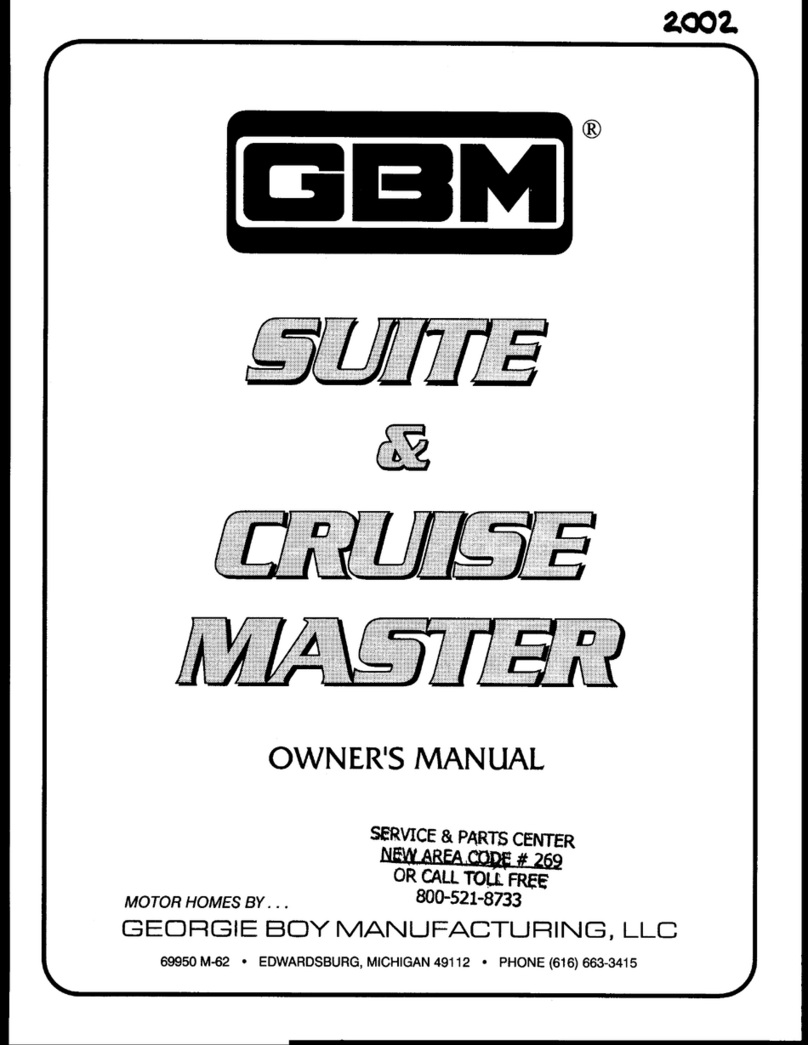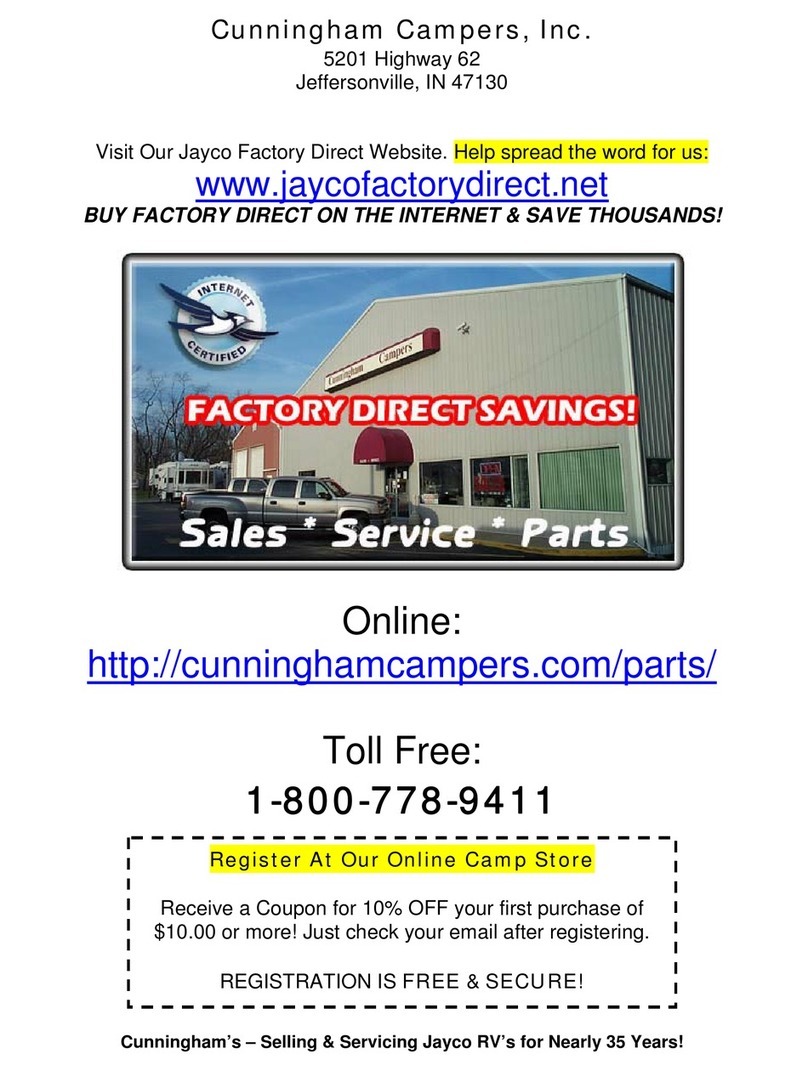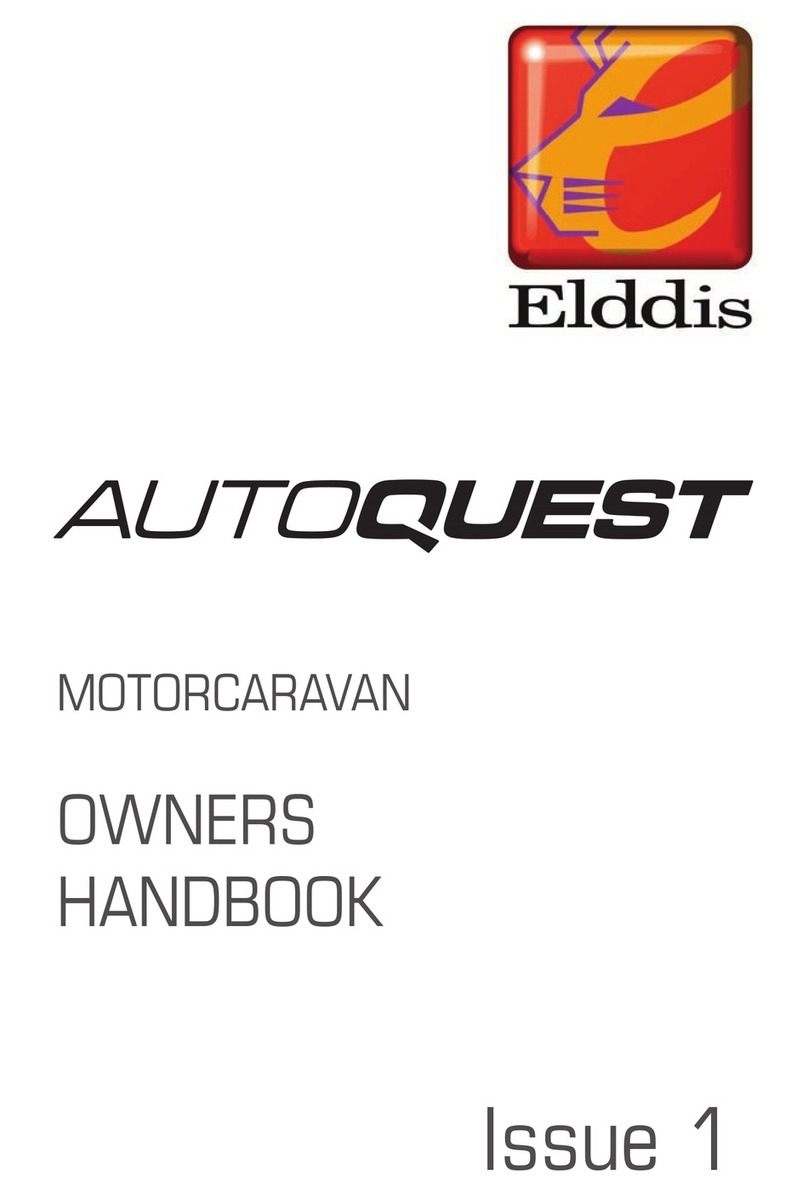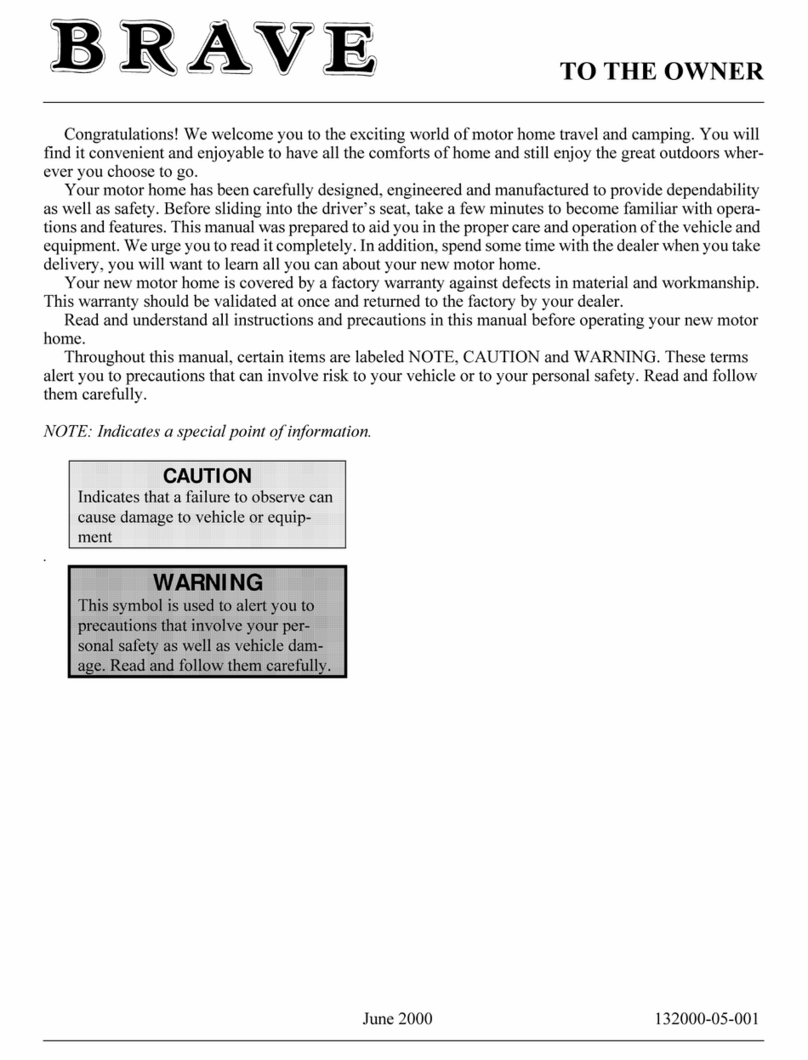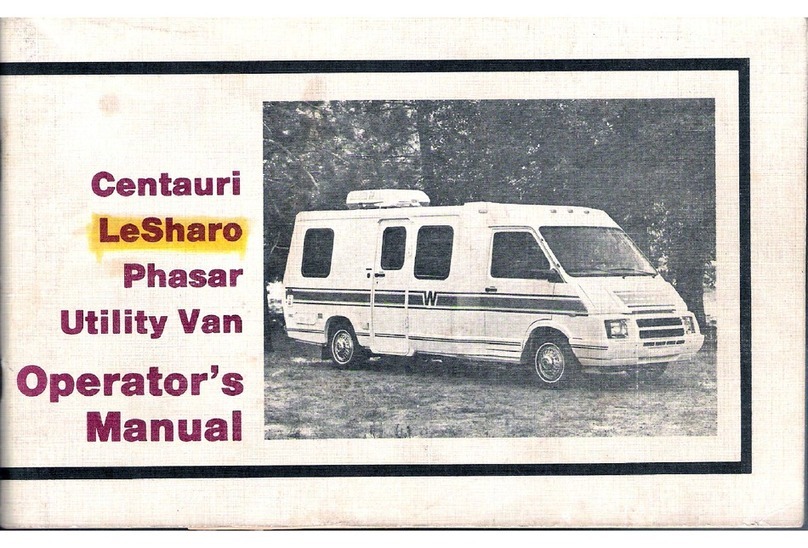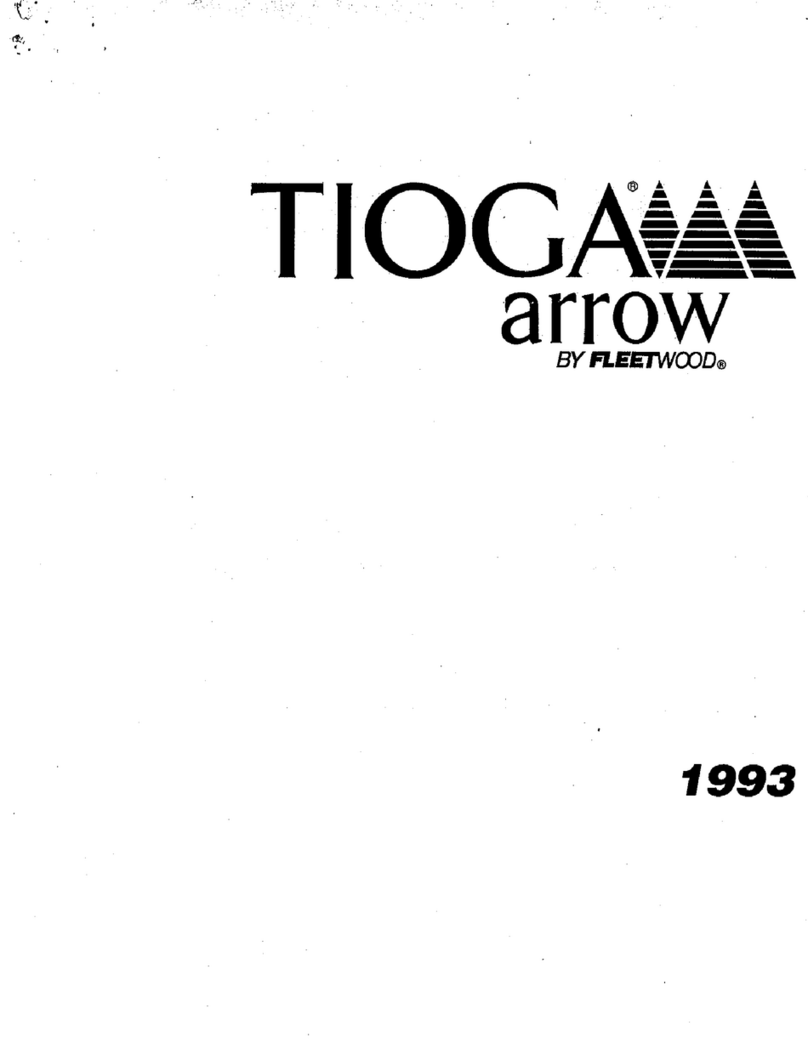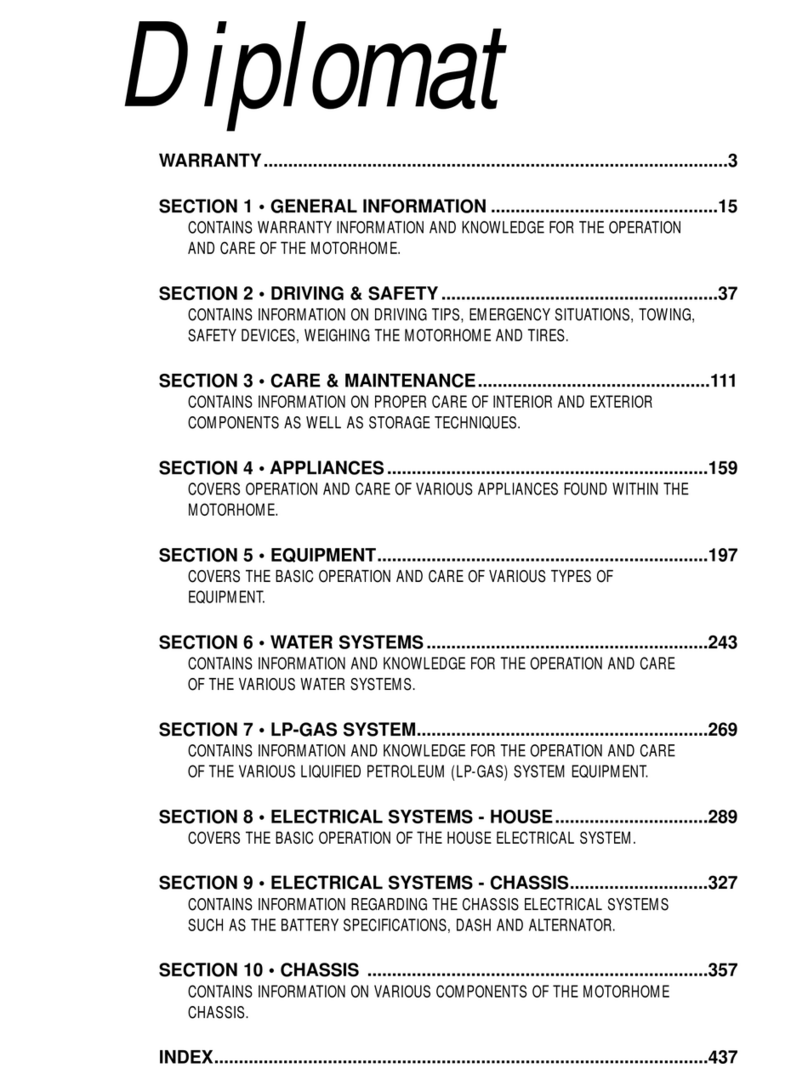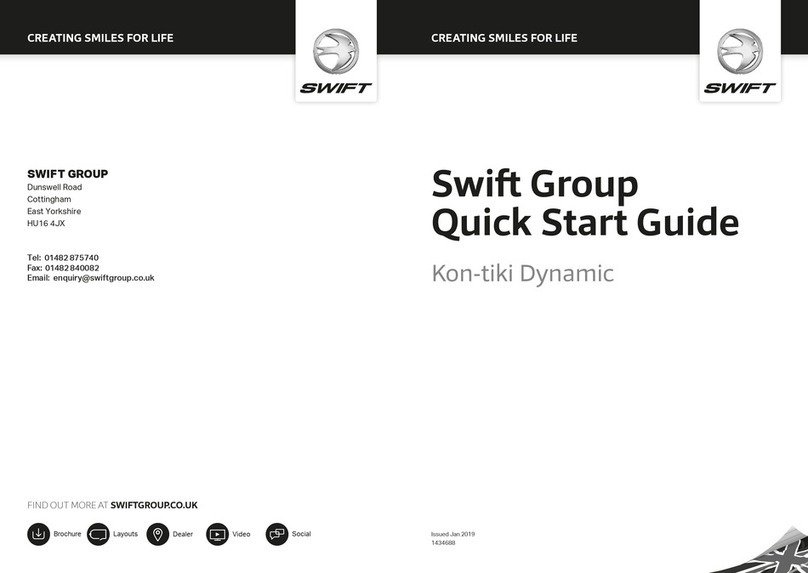Auto-Trail Tribute Series User guide

Auto-Trail VR Limited.
Trigano House, Genesis Way, Europarc,
Grimsby, North East Lincolnshire, DN37 9TU, United Kingdom.
Main Reception: Tel +44(0) 1472 571000 Fax +44(0) 1472 571001
www.auto-trail.co.uk
Parts Department: Tel +44(0) 1472 571003 Fax +44(0) 1472 571002
Together we’re going placeswww.auto-trail.co.uk
OWNER’S HANDBOOK
AUTO-TRAIL |OWNER’S HANDBOOK TRIBUTE & IMALA
OWNER’S HANDBOOK:
23509 2/20 Designed and produced by Kal Group T: +44 (0)1427 610127 www.kal-group.co.uk
ISSUE 1 - 2020 MODELS

Owners Handbook

Your motorhome makes use of many complex
systems and services.
Please ensure that you have read all instruction
manuals carefully, and fully understand all aspects
of your vehicle, before driving it on the open road.
If you have any queries on the operation of any part
of your motorhome please contact your supplying dealer.

Owners Handbook 3
Complete the details below:
Model:
Date Purchased:
Supplying Dealer:
Sales Person:
Telephone Number:
Tyre Pressure:
Radio Code:
Exterior Door Key Number:
Water Filter Key Number:
Vehicle Build Number:
Name: Telephone:
Useful Information

Trigano House, Genesis Way, Europarc,
Grimsby, North East Lincolnshire, DN37 9TU, United Kingdom.
Tel: +44(0) 1472 571000 Fax: +44(0) 1472 571001
e-mail: [email protected]
www.auto-trail.co.uk

5
Contents
Owners Handbook
Useful Information..................................... 3-4
Introduction .............................................. 6-7
Preparing for the Road .............................. 8-9
External Features ...................................10-11
Driving your Motorhome .........................12-13
Selecting a Pitch......................................... 13
Gas Services..........................................14-15
Electrical Services..................................16-18
Leisure Battery ........................................... 19
EC176 Power Control System ..................... 20
EC362 Control Panel.................................. 21
Thetford duplex oven/grill ..................... 22-23
Thetford K1520 Cooker ........................ 24-25
Thetford N4000 Refrigerator.................. 26-27
Dometic RM8501 Refrigerator .................... 28
Truma Combi 4E/6E ............................. 29-33
Whale heat air space heater .................. 33-36
Whale expanse water heater ................. 37-38
Water services........................................... 39
Thetford Cassette Toilet ............................. 40
Windows and Skylights .............................. 41
Electric bed ............................................... 42
Security and Ventilation......................... 43-47
General Care ........................................ 48-50
Winter Laying Up ........................................ 51
Good Neighbour Guide ...........................52-54
Annual Check List..................................55-59
Guarantee & Aftercare............................60-61
Vehicle Specifications/Tyre Pressure .......62-63
Troubleshooting Combi Gas Heater Guide...64-65

Tribute/Imala welcomes you to the ranks of
Tribute/Imala owners.
This handbook has been designed to enable
you to derive the maximum benefit and
enjoyment from your motorhome;
its information will be beneficial to
experienced and new motorhomers alike.
Thank you for deciding to buy one of our
motorhomes and welcome to the ranks of
Auto-Trail owners.
This handbook has been designed to
enable you to derive the maximum benefit
from your motorhome; it’s information will
be beneficial to both experienced and new
motorhomers alike.
The information contained in this handbook
is intended to give you a general guide as
to the care, use and maintenance of your
vehicle. We would advise you to read all
of the individual appliance instructions
that will be found in the information wallet
supplied with your vehicle prior to using
them for the first time.
Your motorhome is designed to give many
years of use as a leisure purpose vehicle
and not as a permanent residence.
Regular maintenance however will not only
ensure trouble free service, but will also
enhance your vehicles value.
Your supplying dealer is responsible for all
aspects of your customer care.

7
Introduction
Owners Handbook
We would suggest that you make a note of the
dealers name and contact information in the
dedicated space in the front of this handbook as
this would speed up the process of answering
any queries you may have. Should you require
assistance, your supplying dealer is fully
conversant with the correct procedures that
should be followed to get any issues resolved in
a timely manner.
For total piece of mind all Auto-Trail vehicles
are supplied with a comprehensive warranty.
Please ensure that your supplying dealer has
fully explained all aspects of the terms and
conditions of your vehicle warranty and the
necessary servicing requirements.
Please refer to the base vehicle handbook for
matters relating to the motorhome as a road
going vehicle (e.g. lubricant levels, service
intervals etc…).
Notes on private exporting of vehicles
Auto Trail Motorhomes are designed and
manufactured to operate in a specific country or
region and therefore it is imperative that when
purchasing a new vehicle, the buyer should be
completely aware of the design and operating
parameters of the product. Vehicles purchased
in the UK are not only built to the necessary
European Directives and Standards (e.g.
ECWVTA – Type approval), but also
are equipped with components that are
designed to operate in a typical European
temperate climate.
Should a customer choose to export a
registered vehicle from the UK, or purchase a
vehicle from a nonaligned dealership outside
the UK, it is their responsibility to ensure
that any required modifications have been
completed to the correct standard, and that
the vehicle complies with all legislation of the
country in which the vehicle is to be registered.
Any equipment that is operated in a country
that it is not designed for will either not perform
correctly and could possibly fail. This equipment
may also not be covered by the appliance
manufacturer’s warranty.
Similarly, Auto-trail vehicles are designed to
be used on normal tarmacadam roads, with
occasional off road campsite use. Should a
vehicle be used outside of these conditions,
the vehicle could suffer undue load, stress and
ingress of debris and therefore Auto-trail will
not be held liable for any such failure and as a
result any applicable warranty will be void.
Modifications To Your Vehicle
Please check with your supplying dealer before
carrying out any modifications to your vehicle.
Any unauthorised modifications carried out by
a third party could affect the terms of your
warranty agreement.
We would always advise that you consult your
dealer before any additional equipment is fitted
to your vehicle to ensure the appropriate fixing
support is available.
Appliance Maintenance
In the interest of safety, replacement parts for
an appliance shall conform to the appliance
manufacturers specifications, and should be
fitted by him or his authorised agent.

Loading Your Vehicle
All models manufactured by Tribute are of
a well balanced design, the most common
causes of poor stability include:
• Poor weight distribution of the weight inside
the vehicle.
• Incorrect tyre pressure (always adhere to
the tyre pressures stated in the chassis
manufacturers handbook. Always inflate
to the ‘fully laden’ condition).
Try to load heavy items down near the floor of
the vehicle, between the axles and as evenly
as possible side to side.
We would recommend that the table is stored
on the floor between the beds if there is no
dedicated storage position.
Where a dedicated storage position is
available, the table should be retained in this
position whilst the vehicle is in motion.
Roof Bars
Your vehicle may be fitted with roof side
styling bars, these bars are not suitable for
carrying any load. Should you wish to fit a
roof rack please contact your supplying
dealer who will be able to supply you with
the relevant information.
Please be advised that the maximum weight
that should be carried on the roof is 40kg
Please be aware that in certain
conditions the aluminium roof may
become very slippery, please take
extreme care should you choose
to walk on the vehicle roof.
Bicycle Carrier (If Fitted)
Tribute recommends that if a bicycle carrier
is fitted to your vehicle it should be capable of
carrying no more than two cycles.
Never exceed the maximum authorised weight
that should be specified on the carrier.
Tow Bars
Auto-Trail only recommends the fitting of
bespoke Witter tow-bars to our vehicles
(where applicable). These are the only
tow-bars that Auto-Trail have tested and
obtained European Type Approval for.
Should you choose to fit any other tow-bar
it is your responsibility to ensure that you do
not contravene any road traffic regulations.
Preparing For The Road
Preparing For The Road

9
Maximum Loading Of Your Vehicle
The weights of your vehicle are stated in the back
of this handbook and on the secondary weight
plate located in the engine bay of your vehicle.
The secondary weight plate gives the
following information.
The serial number of your vehicle which should
be quoted in any correspondence with your
supplying dealer.
• The maximum authorised weight of
your vehicle which must never be exceeded
when the vehicle is loaded and in use.
• The gross train weight of your vehicle.
This is the maximum combined weight of the
actual motorhome fully loaded to its maximum
authorised weight, plus the allowance for a
trailer. The weight of the loaded motorhome
and trailer must never exceed the gross train
weight quoted on the weight plate.
• ‘1’ is the maximum authorised weight for the
individual front axle
• ‘2’ is the maximum authorised weight for the
individual rear axle.
• ‘3’ is the maximum authorised weight of the
individual third axle (only used on twin rear
axle models).
Please note that if you add both maximum
authorised axle weights together it will
normally give you a larger figure than the
maximum authorised weight (MAW) –
please be aware that the Maximum
authorised weight (MAW) must never
be exceeded.
Please take care to ensure that you have allowed
for the masses of all items you intend to carry in
the motorhome. e.g. passengers, optional
equipment, essential habitation equipment and
personal effects such as clothing, food, pets,
bicycles, sailboards, sports equipment, etc.
Before You Set Off In Your Motorhome
• Ensure all articles are stowed securely.
Do not store tins, bottles or heavy items
in overhead lockers.
• Close and secure all lockers and
cupboard doors.
• Secure all bunks.
• Close and secure all roof lights.
• Store main table in transit position.
• Ensure fridge is on 12v operation and set
door lock.
• Close and latch all windows (never drive with
windows on night settings).
• Leave all curtains and blinds open to
aide visibility.
• Ensure leisure battery is secure.
• Ensure all gas appliances are turned off,
that the gas bottles are correctly positioned,
secured and turned off.
• Ensure that seat swivels (if fitted) are locked
in the forward facing position.
• Ensure entrance step is retracted.
Preparing For The Road
Owners Handbook

A Fridge vents
B Side marker lights
C T.V. aerial
(omni-directional, where fitted)
Model shown Tribute F70
External Features
C
A
B

11
D Awning light (where fitted)
E Lockable external access door to toilet waste tank
FRear marker lights
G High level brake light (where fitted)
H Lockable fresh water filler
External Features
Owners Handbook
HE
DGF

Pulling Away
When pulling away in your motorhome always
operate the clutch smoothly, change gears
smoothly and try not to jerk the clutch.
Motorhome Handling
Please remember that your motorhome is
much larger than a standard motor car when
carrying out any manoeuvres.
• Allow longer to speed up when overtaking.
• Do not swing out suddenly.
• Carry out all manoeuvres as smoothly
as possible.
• Use the nearside wing mirror to check
motorhome has cleared obstacle
when overtaking.
• Do not bump the kerbs with the
motorhome wheels.
• Reduce speed accordingly in strong winds,
going downhill or in poor visibility.
• Large high speed vehicles cause air
buffeting, extra care must be taken
when passing or being passed by a
high-sided vehicle.
Reversing
Proficiency at reversing can only be achieved
with practice and we would recommend that
you should first practice in a large open area.
As well as this courses are run by
many organisations.
Reversing Aid
Your vehicle may be fitted with a visual
reversing aid. This aid is designed to assist
a drivers attention only during reversing of
the vehicle, they are not intended to replace
a drivers self judgement. Auto-Trail will not
accept any responsibility for any accident
caused by a drivers negligence.
Navigation Aid
Your vehicle may be fitted with an audio/visual
navigation aid. This navigation aid is designed
to assist the driver whilst travelling, it is not
meant to replace a driver’s self-judgement
as to the suitability of a specific route for
their vehicle. Auto-Trail will not accept any
responsibility for any accident caused by a
driver’s negligence.
Driving Your Motorhome
Driving Your Motorhome

13
Changing A Wheel (Where Applicable)
• Ensure handbrake is fully applied and use
wheel chocks if necessary to ensure the
vehicle cannot move.
• Remove the wheel trims (if fitted). Use the
wheel-brace to slacken off wheel nuts on
the wheel to be changed.
• Position the jack under the axle or at the
appropriate jacking point.
• Jack up the vehicle until the wheel to be
changed is just off the ground.
• Remove the wheel nuts and wheel.
• Fit the spare wheel and reverse the
above procedure.
• Tighten all nuts equally.
Alloy Wheels / Tyre Valves
It is vitally important that when you get
replacement tyres fitted to your vehicle the valves
that are used are capable of
withstanding the high pressures associated
with motorhome tyres.
Usually only ‘bolt through’ steel type valves can
withstand the high pressures associated with
motorhome tyres.
Driving Abroad
Please ensure that you are familiar with the
relevant laws and regulations that apply in the
countries in which you choose to travel.
Different mainland European countries have
different laws and regulations and it is your
responsibility to ensure that your vehicle
complies with theses regulations and
that you drive within the law.
Do not pitch in a position in which your vehicle will
obstruct others coming in.
Try to choose an area that is dry, reasonably level
and preferably with a hard base. If you have no
alternative but to pitch on a slope, ensure that
when you leave you are driving down the slope.
It is always good practice to chock the wheels
of the motorhome when parked on a slope or a
slippery surface even when the brakes are applied.
In poor site conditions you are advised to try to
keep engine revs as low as possible to try to
avoid wheel spin and to try to steer as straight
as possible.
Levelling The Motorhome
Levelling of the motorhome on your chosen
pitch must be carried out in both directions
for the refrigerator and other equipment to
function correctly. Levelling the motorhome
should be carried out using proprietary
levelling ramps, or boards.
Selecting A Pitch
Model shown Imala 730 HB
Owners Handbook
Selecting A Pitch

The gas appliances in your vehicle are fed
from a gas cylinder that is housed in a sealed
cylinder compartment.
Gas flows from the gas bottles via a bulkhead
mounted gas regulator. This regulator provides
a working gas pressure of 30 m bar (1.5kg of
gas per hour).
All appliances installed by Tribute are designed
to work within this pressure range.
Please ensure that any additional appliances,
not fitted by Tribute, are capable of working
within this pressure.
Cylinder Compartment
Your vehicle is designed to accept either 15kg
or 7kg gas cylinders, this is dependent on the
model you have chosen.
The compartment is accessed via a door on the
outside of the vehicle. This door is secured by
two locks.
The Compartment has low level ventilation to
ensure the safe operation of the cylinders and
should not be obstructed in any way.
Also please ensure that any additional items
stored in this compartment are secure and
cannot damage any pipe work or fittings,
or block the ventilation.
Connecting / Changing A Gas Cylinder
Before you can connect a gas cylinder to your
vehicle you will have to obtain the correct type
of high pressure hose for the type of bottle you
have chosen (different European countries
have different connections). This hose should
be fitted to the bulkhead mounted gas regulator
fitted inside your gas compartment.
• Extinguish any fire, Flame or source if ignition
before changing gas cylinders
• Carefully position the gas cylinders into the
gas compartment locating the bottle into the
retaining devices taking care not to damage
any of the pipe work or fittings.
• Tighten the straps that will hold the cylinders
firmly into the compartment.
• Connect the high pressure hose to the gas
cylinder using a suitable tool. Please ensure
that the high pressure hose is connected
correctly before opening the cylinder valve.
Externally sited cylinders
You are advised that gas cylinders should
not be sited outside the motorhome and
that gas hoses should never be extended to
accommodate this. Hose lengths should be no
more than 400mm (+50mm / -100mm).
Gas Services
Gas Services

15
If gas bottles are to be removed for a long period
of time then care should be taken to ensure that
debris cannot enter the gas system via the open
pipe work.
Gas Hoses
Your supplying dealer will advise on the correct
type of high pressure hose to connect your gas
cylinder to the pressure regulator.
This will depend on the type of gas cylinders
you have chosen to carry in your vehicle.
This hose must be replaced at intervals not
exceeding 5 years from the manufacturing
date marked on the hose, or as recommended
in the hose manufacturer’s instructions.
Any hose that shows signs of damage or splitting
should be replaced immediately irrespective of
its age.
Gas Safety Valves
Gas flows from the gas cylinder via a bulkhead
mounted regulator to a set of safety shut off valves
that supply each individual appliance in the vehicle.
The valves allow isolation of a single appliance
without affecting the operation of other equipment.
Each valve has a symbol fixed to it that indicates
which appliance it is supplying.
The location of the isolation valves varies from
model to model, and depending on the layout some
vehicles may have two individual sets of valves.
Please familiarise yourself with the location of these
valves before using your vehicle for the
first time.
Precautions - If a gas leak is suspected
• Turn off the gas supply at the cylinder using
the isolation valve on top of the gas bottle.
• Never search using a match.
• Open all doors and windows to allow any
gas to escape.
• LPG has been given a smell by the
manufacturers to help with the detection of
leaks – check that the gas is not escaping
from an unlit appliance.
• Do not operate any electrical apparatus,
especially light switches.
• If the leak is not obvious the motorhome should
be evacuated and qualified personnel consulted.
• Remember that gas is heavier than air and
therefore sinks to the lowest point.
• Keep bottled gas containers outside and protect
against frost. If storage inside is the only option
then keep away from heat sources.
Gas Services
Owners Handbook

All vehicles have both a 12v and 230v
electrical system.
The 12v electrical system is supplied by a
rechargeable leisure battery that is located
in a dedicated battery compartment within
the vehicle (locations of leisure batteries
varies from model to model so please
familiarise yourself with your battery location
prior to using the vehicle for the first time).
The leisure battery is charged either by the
vehicle alternator when the engine is running,
or by the on board battery charger when the
vehicle is connected to a suitable mains supply
via the hook-up lead supplied with the vehicle.
Connection the mains supply also activates the
230v sockets and 230v lights (where fitted to
a vehicle), as well as various mains appliances.
All vehicles utilise a combined
power supply unit (PSU) that contains the
battery charger, 12v fuses, mains RCD
(residual circuit breaker) and MCB’s
(miniature circuit breakers).
Please familiarise yourself with the location of
the PSU unit prior to using the vehicle for the
first time (individual specifications of PSU
units will be described in more detail later
in this section).
Connecting The Vehicle To A
Mains Supply
Your vehicle is supplied with an orange
mains hook-up cable that will connect your
motorhome to a suitable power supply
on site via the mains hook-up point on
your motorhome.
Mains hook-up points vary from model
to model
so please familiarise yourself with your
particular location prior to using your
vehicle for the first time.
Your motorhome should only be connected
to a supply that meets the requirements
of BS7671.
The site warden will hold information regarding
the suitability of supply.
• Locate the charger power switch on the PSU
unit and switch to the ‘OFF’ position before
connecting the mains supply.
• Connect the supplied hook-up cable
(orange cable with blue connectors)
to the motorhome and then connect
to the mains supply.
• Check the RCD operation by ensuring
that the RCD is switched ‘ON’ (lever in
up position). Press the ‘TEST’ button
and confirm that the RCD is turned off
(lever in ‘DOWN’ position).
Electrical Services
Electrical Services

17
• Switch the RCD back into the ‘ON’ position
(lever in ‘UP’ position). If the button failed to
operate the RCD seek professional advice
from a qualified electrician.
• Check the polarity of the mains supply by
locating the Reverse Polarity indicator and
ensure that the indicator is not illuminated.
If the indicator is illuminated seek advice
from a professional electrician.
• Locate the MCB’s within the PSU (adjacent
to the RCD) and ensure they are all in the
‘ON/UP’ position. If any MCB’s cannot be
reset this could indicate a fault or an
overloaded circuit.
• Locate the power switch on the PSU and turn
to the ‘ON’ position. The switch will illuminate
when turned on.
It is now safe to check the operation of the 12v
and 230v equipment.
Overseas Connections
Connection to mains voltage overseas requires
particular attention. Electricity supplies abroad may
be of reverse polarity. The significance of
this is that when an appliance is switched off,
it may not be electrically isolated.
It is useful to check the polarity of the supply
so that the connection can be made neutral to
neutral and live to live as recommended. Your
Tribute, however, is fitted with a double pole
circuit breaker. Check that all motorhome
equipment is set to accept the site supply prior
to switching it on.
Please note that if too many appliances are
in operation at one time, the MCB
may trip. This is a safety measure.
On some sites, the power is not sufficient
to power all items. If in doubt, consult the
site manager or warden.
Wiring of connecting cable and motorhome
mains inlet:
Pitch outlet supply
Cable plug
Cable coupler
Flexible Wiring Fixed Wiring
Brown Live Red
Blue Neutral Black
Green/Yellow Earth Green/Yellow
Electrical Services
Owners Handbook

Motorhome mains inlet
The cable plug is connected to the cable
coupler by a 2.5mm flexible 3-core cable.
Warning:
It is essential that connections are
made exactly as shown. If the terminal
markings are not in accordance with
the diagram, they must be ignored. If in
doubt, consult a qualified electrician.
Generators
If a generator is fitted, the vehicle must be
regularly serviced to achieve the
optimum performance.
Engine speed is used to govern the output and
frequency of the unit in KW and Hz, and if this is
allowed to vary beyond a safe level, permanent
damage could be caused to certain electronic
equipment such as 12v chargers, etc.
IMPORTANT
Periodically, preferably not less than
once a year, the motorhome electrical
installation should be inspected and
tested. A report on the condition
should be obtained as described in the
Regulations for Electrical Installations,
published by the Institute of Electrical
Engineers. It is important that
the main switch at the site point
should be switched off, the supply
flexible cable disconnected and any
cover replaced on the socket outlet at the
site supply point. It is dangerous
to leave the supply flexible
cable connected.
If a fault should develop with your
electrical system that is not described
in the ‘fault table’ and your supplying
dealer cannot resolve the problem,
Sargent Electrical Systems operate a
telephone help line that is available
during normal office hours.
Tel: 01482 678981
Electrical Services
Electrical Services

19
Your vehicle is equipped with a rechargeable
leisure battery that is located in a dedicated battery
compartment within your vehicle.
Locations of leisure batteries vary from model
to model, so please familiarise yourself with your
battery location before using your vehicle for the
first time. The battery is charged via the on-board
charging unit when the vehicle is plugged into a
mains supply, or via the vehicle alternator whilst
your motorhome is being driven.
Connecting and disconnecting the battery
Please ensure that all cigarettes are extinguished
before working in the auxiliary battery compartment.
Switch off all appliances and lamps before
disconnecting the leisure battery.
• Release the battery securing bolts or
securing straps from the leisure battery.
• Carefully remove the battery from the battery
compartment (please take care – the leisure
battery is extremely heavy).
• Release the battery terminals using a
suitably sized spanner.
To refit the battery, simply reverse the above procedure.
Please ensure the battery is located safely and
securely before driving your motorhome.
Leisure Battery
Owners Handbook
Leisure Battery
This manual suits for next models
15
Table of contents
Other Auto-Trail Motorhome manuals
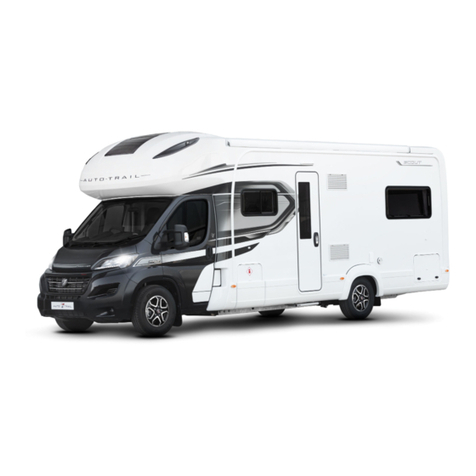
Auto-Trail
Auto-Trail Cheyenne User guide
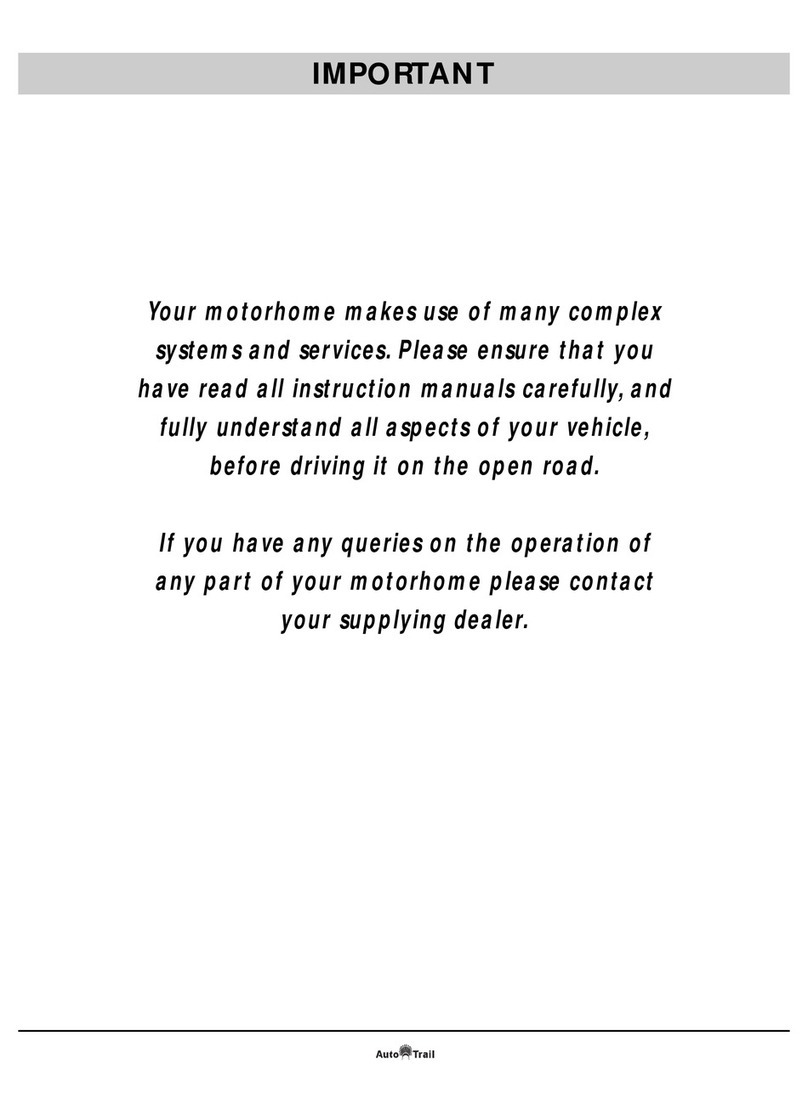
Auto-Trail
Auto-Trail Motorhome User manual

Auto-Trail
Auto-Trail FRONTIER User guide

Auto-Trail
Auto-Trail V LINE 540 SE 2020 User guide
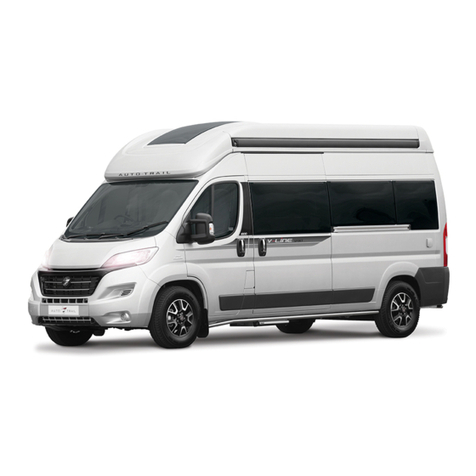
Auto-Trail
Auto-Trail 2015 V-Line User guide

Auto-Trail
Auto-Trail 2006 User guide

Auto-Trail
Auto-Trail Motorhome Installation guide
Auto-Trail
Auto-Trail Tracker User guide

Auto-Trail
Auto-Trail Excel User guide

